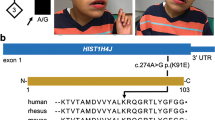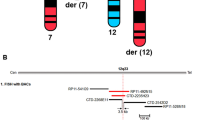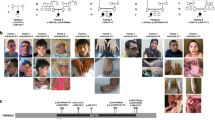Abstract
Copy number variants (CNVs) are major contributors to genetic disorders1. We have dissected a region of the 16p11.2 chromosome—which encompasses 29 genes—that confers susceptibility to neurocognitive defects when deleted or duplicated2,3. Overexpression of each human transcript in zebrafish embryos identified KCTD13 as the sole message capable of inducing the microcephaly phenotype associated with the 16p11.2 duplication2,3,4,5, whereas suppression of the same locus yielded the macrocephalic phenotype associated with the 16p11.2 deletion5,6, capturing the mirror phenotypes of humans. Analyses of zebrafish and mouse embryos suggest that microcephaly is caused by decreased proliferation of neuronal progenitors with concomitant increase in apoptosis in the developing brain, whereas macrocephaly arises by increased proliferation and no changes in apoptosis. A role for KCTD13 dosage changes is consistent with autism in both a recently reported family with a reduced 16p11.2 deletion and a subject reported here with a complex 16p11.2 rearrangement involving de novo structural alteration of KCTD13. Our data suggest that KCTD13 is a major driver for the neurodevelopmental phenotypes associated with the 16p11.2 CNV, reinforce the idea that one or a small number of transcripts within a CNV can underpin clinical phenotypes, and offer an efficient route to identifying dosage-sensitive loci.
This is a preview of subscription content, access via your institution
Access options
Subscribe to this journal
Receive 51 print issues and online access
$199.00 per year
only $3.90 per issue
Buy this article
- Purchase on Springer Link
- Instant access to full article PDF
Prices may be subject to local taxes which are calculated during checkout




Similar content being viewed by others
References
Stankiewicz, P. & Lupski, J. R. Structural variation in the human genome and its role in disease. Annu. Rev. Med. 61, 437–455 (2010)
Weiss, L. A. et al. Association between microdeletion and microduplication at 16p11.2 and autism. N. Engl. J. Med. 358, 667–675 (2008)
McCarthy, S. E. et al. Microduplications of 16p11.2 are associated with schizophrenia. Nature Genet. 41, 1223–1227 (2009)
Jacquemont, S. et al. Mirror extreme BMI phenotypes associated with gene dosage at the chromosome 16p11.2 locus. Nature 478, 97–102 (2011)
Walters, R. G. et al. A new highly penetrant form of obesity due to deletions on chromosome 16p11.2. Nature 463, 671–675 (2010)
Kumar, R. A. et al. Recurrent 16p11.2 microdeletions in autism. Hum. Mol. Genet. 17, 628–638 (2008)
Baldini, A. Dissecting contiguous gene defects: TBX1. Curr. Opin. Genet. Dev. 15, 279–284 (2005)
Lupski, J. R. et al. DNA duplication associated with Charcot-Marie-Tooth disease type 1A. Cell 66, 219–232 (1991)
Brunetti-Pierri, N. et al. Recurrent reciprocal 1q21.1 deletions and duplications associated with microcephaly or macrocephaly and developmental and behavioral abnormalities. Nature Genet. 40, 1466–1471 (2008)
Sanders, S. J. et al. Multiple recurrent de novo CNVs, including duplications of the 7q11.23 Williams syndrome region, are strongly associated with autism. Neuron 70, 863–885 (2011)
Sebat, J. et al. Strong association of de novo copy number mutations with autism. Science 316, 445–449 (2007)
Stefansson, H. et al. Large recurrent microdeletions associated with schizophrenia. Nature 455, 232–236 (2008)
Shinawi, M. et al. Recurrent reciprocal 16p11.2 rearrangements associated with global developmental delay, behavioural problems, dysmorphism, epilepsy, and abnormal head size. J. Med. Genet. 47, 332–341 (2010)
Roa, B. B. et al. Charcot-Marie-Tooth disease type 1A. Association with a spontaneous point mutation in the PMP22 gene. N. Engl. J. Med. 329, 96–101 (1993)
Slager, R. E., Newton, T. L., Vlangos, C. N., Finucane, B. & Elsea, S. H. Mutations in RAI1 associated with Smith-Magenis syndrome. Nature Genet. 33, 466–468 (2003)
Talkowski, M. E. et al. Assessment of 2q23.1 microdeletion syndrome implicates MBD5 as a single causal locus of intellectual disability, epilepsy, and autism spectrum disorder. Am. J. Hum. Genet. 89, 551–563 (2011)
Lindsay, E. A. et al. Tbx1 haploinsufficieny in the DiGeorge syndrome region causes aortic arch defects in mice. Nature 410, 97–101 (2001)
Peça, J. et al. Shank3 mutant mice display autistic-like behaviours and striatal dysfunction. Nature 472, 437–442 (2011)
Ceol, C. J. et al. The histone methyltransferase SETDB1 is recurrently amplified in melanoma and accelerates its onset. Nature 471, 513–517 (2011)
Takeda, H., Matsuzaki, T., Oki, T., Miyagawa, T. & Amanuma, H. A novel POU domain gene, zebrafish pou2: expression and roles of two alternatively spliced twin products in early development. Genes Dev. 8, 45–59 (1994)
Detrich, H. W., III, Westerfield, M. & Zon, L. I. Overview of the Zebrafish system. Methods Cell Biol. 59, 3–10 (1999)
Crepel, A. et al. Narrowing the critical deletion region for autism spectrum disorders on 16p11.2. Am. J. Med. Genet. B. Neuropsychiatr. Genet. 156, 243–245 (2011)
Cooper, G. M. et al. A copy number variation morbidity map of developmental delay. Nature Genet. 43, 838–846 (2011)
Barge-Schaapveld, D. Q., Maas, S. M., Polstra, A., Knegt, L. C. & Hennekam, R. C. The atypical 16p11.2 deletion: a not so atypical microdeletion syndrome? Am. J. Med. Genet. A. 155, 1066–1072 (2011)
Azizieh, R. et al. Progressive myoclonic epilepsy-associated gene KCTD7 is a regulator of potassium conductance in neurons. Mol. Neurobiol. 44, 111–121 (2011)
Willer, C. J. et al. Six new loci associated with body mass index highlight a neuronal influence on body weight regulation. Nature Genet. 41, 25–34 (2009)
He, H., Tan, C. K., Downey, K. M. & So, A. G. A tumor necrosis factor alpha- and interleukin 6-inducible protein that interacts with the small subunit of DNA polymerase delta and proliferating cell nuclear antigen. Proc. Natl Acad. Sci. USA 98, 11979–11984 (2001)
Courchesne, E. et al. Neuron number and size in prefrontal cortex of children with autism. J. Am. Med. Assoc. 306, 2001–2010 (2011)
Horev, G. et al. Dosage-dependent phenotypes in models of 16p11.2 lesions found in autism. Proc. Natl Acad. Sci. USA 108, 17076–17081 (2011)
Beckmann, J. S., Estivill, X. & Antonarakis, S. E. Copy number variants and genetic traits: closer to the resolution of phenotypic to genotypic variability. Nature Rev. Genet. 8, 639–646 (2007)
Crespi, B., Stead, P. & Elliot, M. Evolution in health and medicine Sackler colloquium: comparative genomics of autism and schizophrenia. Proc. Natl Acad. Sci. USA 107, (suppl. 1), 1736–1741 (2010)
Acknowledgements
We thank C. Hanscom for technical assistance. We also thank J. Black, J. Whetstine, K. Brown and C. Lee for assistance with the initial and confirmatory array CGH experiments, S. Santagelo for analysis of clinical phenotype data, and M. State, M. Daley and R. Gibbs for sharing unpublished exome sequencing data. This work was supported by a Silvo O. Conte center grant (MH-094268) from the National Institute of Mental Health (NIMH), National Institutes of Health grant MH-084018 (A.S., A.K. and N.K.), grant MH-091230 (A.K.), grant HD06286 (J.F.G.), the Simon's Foundation, the Autism Consortium of Boston (J.F.G.), the Leenaards Foundation Prize (S.J. and A.R.), the Swiss National Science Foundation (A.R. and J.S.B.), a Swiss National Science Foundation Sinergia grant (S.J., J.S.B. and A.R.). M.E.T. was supported by an NIMH National Research Service Award (F32MH087123). S.J. is a recipient of a bourse de relève académique de la Faculté de Biologie et Médecine de l’Université de Lausanne. N.K. is a Distinguished Brumley Professor.
Author information
Authors and Affiliations
Contributions
Author Contributions C.G. and N.K. designed the study and wrote the paper, and all authors approved and commented on the manuscript. C.G. performed the zebrafish studies, immunostaining, TUNEL and sectioning experiments, and counting analyses. J.W. made the plasmid constructs and capped mRNAs. M.E.T., M.S. and J.F.G. performed the human genetic analyses. E.C.O. performed the shRNA silencing and BrdU pulse experiments, and generated mice brain sections. Y.T., A.S. and A.K. performed in utero electroporations. S.J., A.R. and J.S.B. designed the 16p-specific microarray and shared unpublished data that informed our experimental design.
Corresponding author
Ethics declarations
Competing interests
The authors declare no competing financial interests.
Supplementary information
Supplementary Information
This file contains Supplementary Figures 1-7 and Supplementary Tables 1-3. (PDF 1627 kb)
Rights and permissions
About this article
Cite this article
Golzio, C., Willer, J., Talkowski, M. et al. KCTD13 is a major driver of mirrored neuroanatomical phenotypes of the 16p11.2 copy number variant. Nature 485, 363–367 (2012). https://doi.org/10.1038/nature11091
Received:
Accepted:
Published:
Issue Date:
DOI: https://doi.org/10.1038/nature11091
This article is cited by
-
Integrating non-mammalian model organisms in the diagnosis of rare genetic diseases in humans
Nature Reviews Genetics (2024)
-
Using rare genetic mutations to revisit structural brain asymmetry
Nature Communications (2024)
-
Identifying foetal forebrain interneurons as a target for monogenic autism risk factors and the polygenic 16p11.2 microdeletion
BMC Neuroscience (2023)
-
Dissecting the autism-associated 16p11.2 locus identifies multiple drivers in neuroanatomical phenotypes and unveils a male-specific role for the major vault protein
Genome Biology (2023)
-
Microglial cannabinoid receptor type 1 mediates social memory deficits in mice produced by adolescent THC exposure and 16p11.2 duplication
Nature Communications (2023)
Comments
By submitting a comment you agree to abide by our Terms and Community Guidelines. If you find something abusive or that does not comply with our terms or guidelines please flag it as inappropriate.



